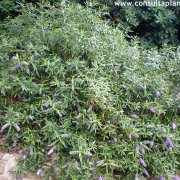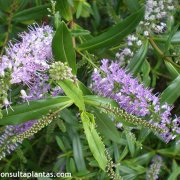Care of the shrub Hebe salicifolia or Willow-leaf hebe |
|
The genus Hebe, family Plantaginaceae, includes 90 species of shrubs native to South America, New Zealand, Australia and some Pacific islands. Sometimes the genus Hebe is included in the genus Veronica. Some species are: Hebe salicifolia, Hebe albicans, Hebe stricta, Hebe speciosa, Hebe diosmifolia, Hebe acutiflora. Common names: Willow-leaf hebe, Koromiko. This species is native to New Zealand and Chile. They are evergreen shrubs that reach 2 meters (6.56 feet) in height. The leaves are long and narrow (up to 12 cm/4.72") and bright green; they look like willow leaves. They produce numerous spikes of small white or mauve flowers. They bloom from summer to early fall. Willow-leaf hebe is used to form screens, as isolated specimens, to fix slopes, in public parks or in large pots for greenhouses, patios and terraces. It's ideal for coastal gardens. Hebe salicifolia needs full sun exposure. It resists frost down to -12 ºC (10.4 ºF). It should be protected from dry winds. The soil must drain well and contain organic matter; Koromiko can grow in poor soils. Water regularly so that the substrate never dries completely; avoid flooding. Willow-leaf hebe resists a few days of drought. Fertilize with compost in late winter and, during the flowering season, with mineral fertilizer every 15 days. Prune in early spring to keep it compact. Hebe salicifolia is sensitive to overwatering (fungal diseases) and to aphids attack if the drought is excessive. Koromiko propagates from seeds sown in spring or by cuttings in summer. |
Images of the shrub Hebe salicifolia or Willow-leaf hebe |
Find plants
Hebe salicifolia or Willow-leaf hebe | Care and Growing
© 2025 FavThemes

